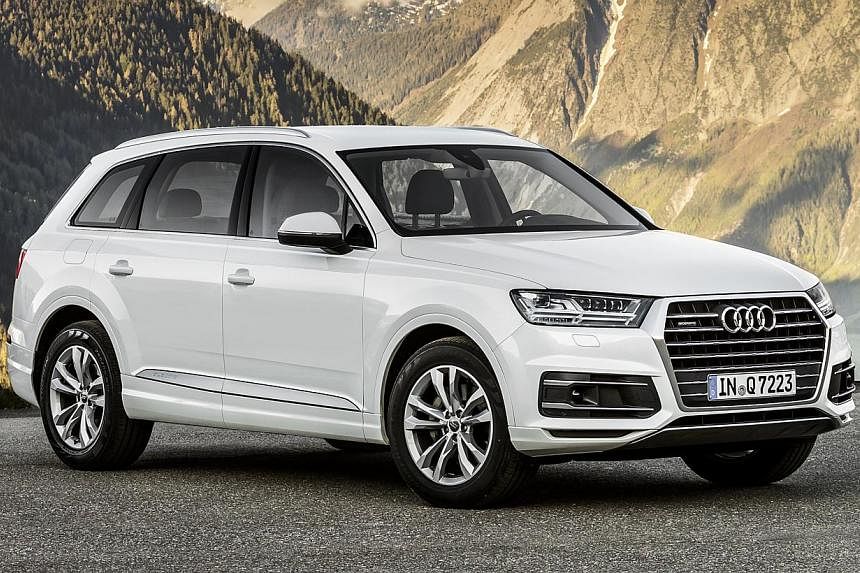Audi's new Q7 is a mirage. Although it is not quite as long or broad as its predecessor and it stands a mite taller, it appears quite the opposite.
Whichever angle you look at it from, the second-generation Q7 - unveiled nine years after the first - comes across more like a muscular wagon than a bulky SUV.
Perhaps the optical illusion has to do with its design. The new car has more angular elements, intricate character lines and larger wheels.
And even though it is sufficiently different, it does not render the outgoing model dull or dated.
Underneath the skin, though, the second Q7 sports a new chassis and new construction materials. Built on a modular platform that the next Porsche Cayenne will share and endowed with a multi-material body that is 71kg lighter yet more rigid than before, the Audi is more fleet-footed and more efficient.
Together with lighter seats, doors, engine cooling system, cabling and other components, overall weight has dropped by 210kg or 9.4 per cent (new 3.0TSFI versus old).
Along with its slightly more compact stature (as well as a shorter wheelbase), 20-inch wheels and all-wheel steering (a highly recommended cost option), the car is set up for agility, manoeuvrability and poise.
That Audi has picked the stomach-churning alpine roads that snake around the Swiss ski resort town of Vernier as the test-drive route shows how confident it is of the new car.
Thankfully, the Q7 does not disappoint. On occasionally sandy hairpins that whip from the left and then to the right almost immediately, the rear-wheel-biased quattro performs like a ballerina across a freshly varnished stage.
There is far less body movement than you would expect of an SUV - another thing to be thankful for. If it were a lesser car on the same route, lost lunches (or worse) might have been the consequence.
The twisty stretches are best tackled in Dynamic mode. But despite the stiffer damping in this mode, neither the cabin nor its occupants are shaken.
The Q7 has always been blessed with an enviable ride which, quite surprisingly, has not been compromised despite the improved dynamism.
This might be attributable to the Audi's redesigned five-link front suspension and rear axles. The car is also quieter, thanks partly to double-glazed windows - all the better for enjoying its "3D" hi-fi system.
There are three engine variants available for test-drive: two 3-litre turbodiesels and a 3-litre TFSI supercharged petrol.
Audi is unlikely to import the turbodiesels. The TFSI has a forced induction V6 that goes back to 2008. It is as unrelenting as before, churning out 333bhp and 440Nm of torque from 2,900rpm.
Even though those numbers are not earth-shattering in today's context, they allow the slimmed-down Q7 to clock the century sprint in 6.3 seconds - down from 6.9 previously. Which is pretty amazing, considering the car is still a shade over 2 tonnes.
Like its predecessor, the engine is paired with an eight-speed Tiptronic gearbox. But Audi says this is a completely revised transmission, with a more efficient spread of ratios. And it incorporates a new centre differential. This contributes to the car's improved stated consumption of 7.9 litres/100km - down dramatically from 10.7 previously.
The car is now fitted with electromechanical steering, which paves the way for a slew of driving and safety aids, some of which will not be available in Singapore.
There is Traffic Jam Assist, which allows the car to convoy in heavy traffic at up to 65kmh - without the driver having to touch the steering wheel or any pedal.
The most amazing feature is Predictive Efficiency Assistant, which works with GPS and adaptive cruise control to actually slow the car down ahead of a turn-off. The car is also obedient to speed limits and will automatically go to a legislated speed whenever you activate the Resume button on the cruise control. You can of course override this, at your own peril.
As expected, the car has a higher level of connectivity than before, with onboard Wi-Fi being one of the options.
The third-row seats can now be folded flat and brought back up at the touch of a button. But passengers getting to this row do not have access to a one-action lever. Also, rear legroom does not seem as adequate as before.
The new Q7 3.0TFSI is slated to arrive around September and is expected to be priced at $370,000 or less. A 2-litre turbo with 250bhp could arrive by year-end. With 19-inch wheels and steel suspension (instead of air), it could go for less than $300,000.
No, that's not a mirage. And yes, it will make the car the most affordable German seven-seater SUV in town.

